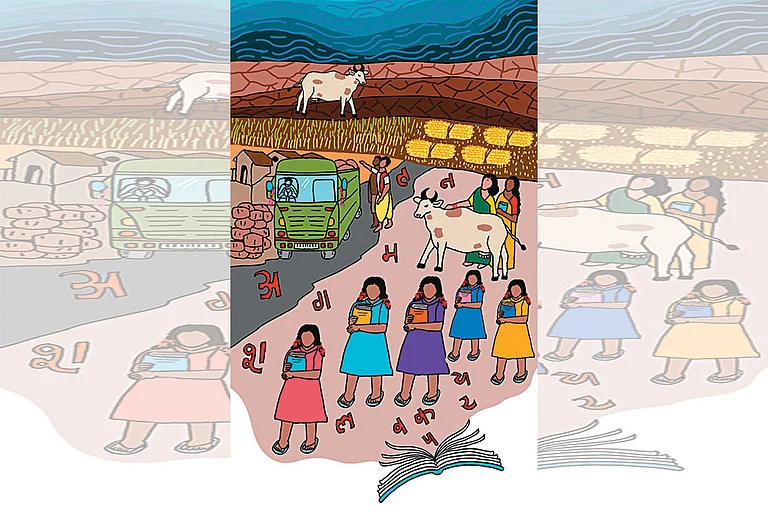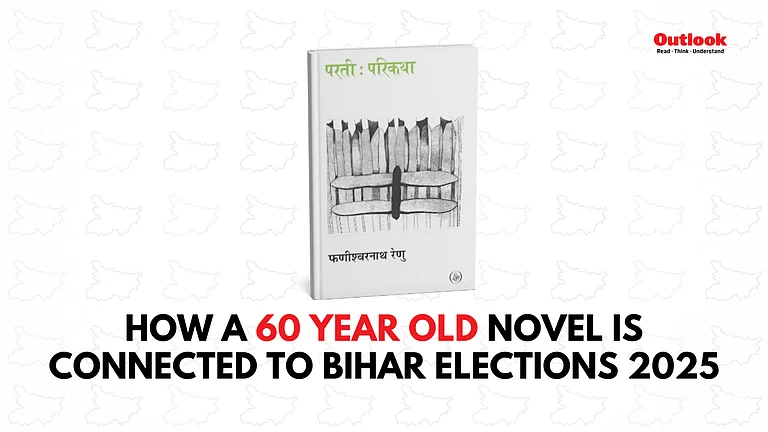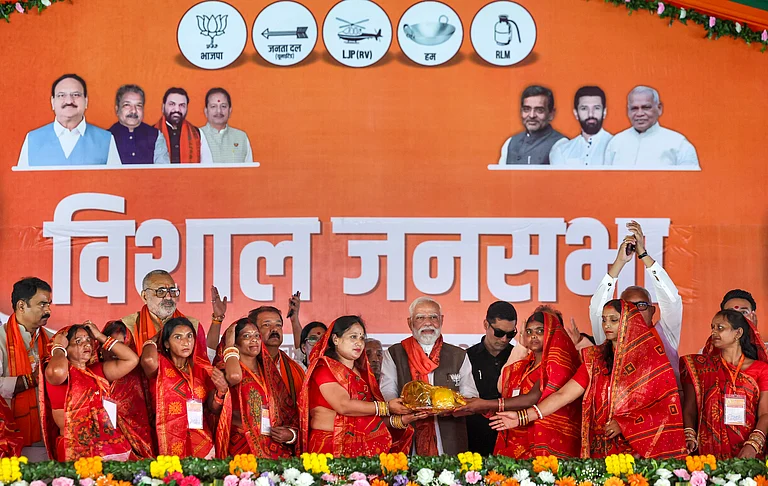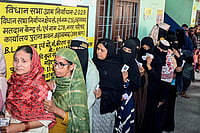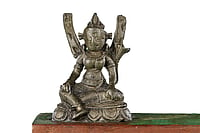
The Chhath celebrations, falling just days before the state elections, inevitably got caught up in the campaign.
If Chhath is a marker of authenticity for Biharis, it is important to the BJP to show that it, too, is Chhath-identified.
All efforts to colonise Chhath indicate the confusion regarding the outcome of the elections.
Bihar’s quintessential Chhath puja has just got over. Falling just days before the state elections, its celebrations inevitably got caught up in the campaign, now in full swing. Of all political parties in the fray, it was the Bharatiya Janata Party (BJP) that attempted hardest to make political capital from it. All BJP Chief Ministers were shown performing elaborate Chhath in their respective state capitals.
The simple Chhath of my youth, when we went before dawn to the banks of the Ganga with my mother, aunts, cousins and some male members of the family, accompanied often by a Muslim or an Oraon friend, waiting for the sun to rise so those who had kept a long and difficult vrat could break their fasts, and we could lay our hands on the thekuas and pedakiyas whose aroma, as they cooked, had filled the house. As the rising sun shimmered on the water, we returned home, receiving and sending prasad to neighbours, friends and relations.
I would have never imagined then that Chhath would become so elaborate, pan-India high decibel and over-the-top as it has this year. The political use of Chhath did not start this year: only a few years ago, Tejashwi Yadav, the Rashtriya Janata Dal’s (RJD) ‘CM Face’ today, had mocked now-deceased BJP leader Sushil Kumar Modi asking if his Christian wife had kept fast. Today, BJP leaders are asking the same question to Tejashwi, who married a Christian woman too.
If Chhath is a marker of authenticity for Biharis, it is important to the BJP to show that it, too, is Chhath-identified. Lacking any leader of stature in Bihar, it fell to BJP allies, Chirag Paswan and Nitish Kumar, to exchange Chhath greetings, Chirag touching Nitish’s feet in a show of exaggerated respect, even as he denied that the latter was the agree-upon CM face for the NDA. Chirag’s glamorous sartorial choice, and choice to perform the aragh in a swimming pool, rather than the Ganga, drew some sharp barbs on social media.
All efforts to colonise Chhath indicate the confusion regarding the outcome of the elections.
Elaborate Chhath videos came from elsewhere in the country. In Delhi, the Chief Minister (CM) Rekha Gupta herself performed the aragh—we do not know if she also fasted—and wrote on social media about the significance of the festival. Much was made about the Delhi government having cleaned the heavily-polluted Yamuna River to make it fit for worshippers to bathe in. In Rajasthan, the Deputy CM Diya Kumari, and the royal rebel Vasundhara Raje, both were shown to perform it. Nayab Saini, the CM of Haryana, claimed, in a nod to the PM, that “Haryana ka Chhath se purana rishta hai”.
Where the BJP CMs themselves did not perform the aragh, they made a show of the facilities they had provided to those who did. Pictures came in from Madhya Pradesh and Maharashtra with Mohan Yadav and Devendra Fadnavis standing with those celebrating. In Patna, the BJP’s current Deputy CM Samrat Chaudhary boasted that his party had put together 14 times more trains for Bihari migrants to return home for this most important festival as compared to the time when RJD supremo Lalu Yadav was railway minister. In Surat, police and party workers were filmed feeding thousands of Bihari migrant workers waiting to board trains to go home. Scenes came of railway station, trains themselves, where Chhath songs were blaring loudly. All these images circulated heavily on social media, in a full-on attempt to fold Chhath into the Sangh’s project of Sanatanising folk Hinduism.
The BJP’s tendency to mobilise Hinduism’s local, folk and minor traditions into its muscular and menacing Hindutva was on full display on social media: scenes of crowded ghats were often accompanied by text claiming this would “burn seculars” or “give nightmares” to political opponents. The BJP’s attempt at the appropriation of Chhath for electoral politics has not been subtle.
Why this pan-Indian party-sponsored Chhath? The BJP, like all the other parties in the electoral fray, is all too aware that over the past decade or two, Bihar migrant workers have spread to all corners of India, and have an important bearing on the Bihar elections. Any party that gets their support stands a good chance to best those that fall behind on this score. Palaayan (exodus) has become a big issue, and both the RJD and Prashant Kishor’s new Jan Suraaj Party have pitched Bihar-based employment as their key issue. Note that the word for migration—pravaas—is not in popular discourse: Palaayan indicates a forced economic compulsion to leave your home, and has a more emotional charge to it that mere ‘pravaas’. Inexplicably for a man with a connect with popular sentiment and with no reservations against making false promises, Prime Minister Narendra Modi slipped here, stating that Bihar could not have large-scale industrialisation, and jobs would be generated by high-tech, AI and even by making reels, the last because he had made mobile phone data so inexpensive. The truth, of course, is that Modi’s development model, and Manmohan Singh’s earlier, depend on cheap migrant labour from Bihar and other poor areas. The over-the-top pan-India Chhath celebrations by the BJP can be seen, then, as a way to neutralise the electoral potency of Palaayan and its solution in Bihar-based employment, a displacement of the political economy of migration on to the terrain of culture.
But for all its efforts, it is not clear that the BJP’s attempt to take over Chhath has been an unqualified success. Everyone needs Bihari migrants, but not everyone likes them. The day after Fadnavis was wishing Biharis, other Mumbaikars posted clips of littered puja sites—they had not been similarly perturbed by trash left behind in the wake of Ganpati Puja weeks earlier, suggesting that creating a seamless Hinduism was not easy in a country with considerable regional chauvinism, in which Biharis are often looked down upon. In Delhi, where the government’s cleaning of the Ganga was its major claim to Chhath glory, it turned out that a notorious troll who was filmed “drinking” Yamuna water to show how clean it was, actually had poured that water down thinking the camera had stopped recording: it had not, and clips of his fraud were spread widely on social media. Modi had to give up the idea of going to the Yamuna for a worship of the sun when it transpired that a separate tank had been created on the banks of the Yamuna and filled with clean water, as the river itself still had high pollution. In one location, Bihari migrant women pointed to snakes in the river, and complained that the ground below the water was full of sharp stones and shards of broken glass. Clips came from Haryana of Biharis forced to worship standing knee-deep in what looked like a drain. Even the railway narrative fell flat: not only because of the hundreds of trains, most were full and uncomfortable, but also because the railway police was shown taking those shooting these clips to task.
Modi had talked about cheap data and the mobile phone light replacing the ‘laaltain’ enabling people to make reels: but the mobile phone and reel-making are double-edge swords, and the disaffected, the dissatisfied and the detractors too were adept at their use in ways counter to those that he had in mind. Clips of the tank by the Yamuna, and the troll ‘drinking Yamuna water’, circulated widely to the merriment and derision of Biharis. It was clear that non-Bihari Hindutva influencers did not ‘get’ Chhath: the fact that non-Hindus also participated, and that the ghats were open to all classes and castes.
All these efforts to colonise Chhath indicate that the confusion regarding the outcome of the elections continues. It was to misdirect voters from the NDA’s dismal record of 20 years in office and to project it as the party that cares most for Chhath. But it seems not to have worked out to plan. So now normal service has resumed—the BJP IT cell is back to make and disseminate clipped videos of ‘Pappu insulting Chhath’, questioning Tejashwi Yadav’s lack of a high school diploma, spectres of Jungle Raj and so on. Prashant Kishor remains a wildcard, and the glorious unpredictability and dogged inscrutability of the Bihari voters, as well as their relative autonomy from Hindutva, make the outcome hard to predict even now. Will stale speeches of star campaigners, repeating stories of Hindu-Muslim antagonism, like an ageing rock star playing their greatest hits from some decades ago, have traction? Will Modi’s popularity, arguably considerably more than that of his party, take the NDA over the line? Or, if Biharis go for ‘badlaav’—a party or a combination of parties? We will all have to wait for November 14, won’t we?
(Views expressed are personal)
This story appeared as Let Chhath Be in Outlook’s November 11 issue, titled "Caste is the Biggest Political Party in Bihar," which explores how caste plays multiple interconnected roles in seat-sharing and coalition-building in the land of the setting sun.









